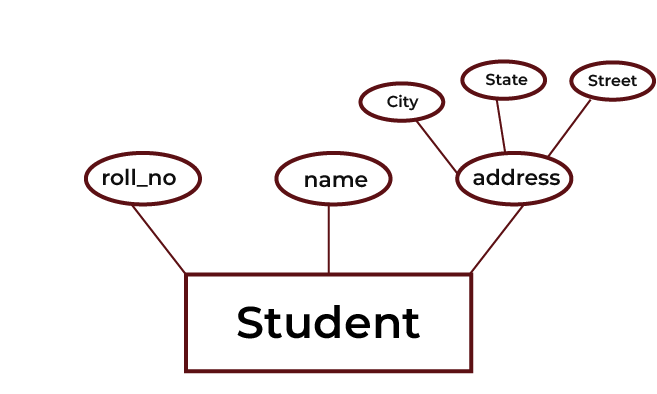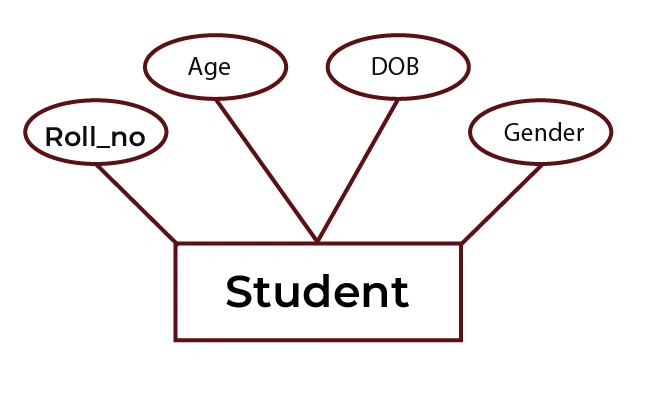Ever wondered how databases store all that data we rely on? Or maybe you’ve asked yourself why certain pieces of information are called attributes. Let’s break it down.
Attributes in DBMS are essential. They define the properties of the data we store. Think of them as the traits that give life to database entities. Without attributes, our data would be a jumbled mess, hard to manage and understand.
Why do we need attributes? Well, they help us organise and retrieve data efficiently. By categorising information into attributes, we make databases more structured and useful.
In this blog, we’ll explore different types of attributes in DBMS using clear examples and straightforward language. Let’s dive in!
Simple Attributes: Definition and Examples
Simple attributes are the most basic type of attributes. They cannot be divided into smaller parts.
For example, think about a student database. The roll number of a student is a simple attribute. It’s unique and doesn’t need a further breakdown. Another example is an employee ID in a company database. It’s straightforward and unique to each employee.
Why are simple attributes important? They provide clear, unambiguous data points that are easy to manage and retrieve.
These attributes in DBMS help maintain a clean and efficient database structure. They ensure that each piece of data is distinct and easily accessible.

SQL Example for Simple Attributes:
CREATE TABLE Students (
StudentID INT PRIMARY KEY,
Name VARCHAR(100),
RollNumber VARCHAR(10) UNIQUE
);
INSERT INTO Students (StudentID, Name, RollNumber) VALUES (1, 'Devesh Kumar', 'RN001');
This code creates a table with a simple attribute, RollNumber, that uniquely identifies each student.

POSTGRADUATE PROGRAM IN
Multi Cloud Architecture & DevOps
Master cloud architecture, DevOps practices, and automation to build scalable, resilient systems.
Composite Attributes: Detailed Explanation and Usage
Composite attributes are a bit more intricate. They are combined with two or more than two simple attributes.
Why use composite attributes? When data is complicated and needs to be kept in a complex form, composite attributes are employed.
Let’s take an example: You want to store the addresses of some people. The characteristic “address” is obtained from the three basic attributes “city,” “state,” and “street.”
We must first obtain those street, state, and city properties to determine the value of the address element. A composite attribute is the name given to this kind of attribute.
The use of composite attributes in DBMS facilitates effective data management. By ensuring that relevant data is saved together, it improves database control and access.

SQL Example for Composite Attributes:
CREATE TABLE Employees (
EmployeeID INT PRIMARY KEY,
FirstName VARCHAR(50),
MiddleName VARCHAR(50),
LastName VARCHAR(50),
Street VARCHAR(100),
City VARCHAR(50),
PostalCode VARCHAR(10)
);
INSERT INTO Employees (EmployeeID, FirstName, MiddleName, LastName, Street, City, PostalCode)
VALUES (1, 'Growth', 'Track', 'Infotech', 'A 62', 'Noida', '201301');
This table includes a composite attribute, Address, represented by multiple columns (Street, City, PostalCode).
Single-Valued Attributes: Characteristics and Implementation
Have you ever wondered why some attributes in a database hold just one value? Why is it that a student’s roll number or a product’s serial number doesn’t change? Let’s dive into single-valued attributes.
Single-valued attributes are straightforward. They hold just one value for each entity instance. Think about it like this: each student has one date of birth, not multiple.
Why are single-valued attributes in DBMS important? They maintain data integrity and make it easy to search and sort data. Let’s break it down with some examples.
Let’s look at an example. In a library database, the ISBN of a book is a simple attribute. It uniquely identifies each book without needing any further details.

SQL Example for Single-Valued Attributes:
CREATE TABLE Students (
StudentID INT PRIMARY KEY,
Name VARCHAR(100),
DateOfBirth DATE
);
INSERT INTO Students (StudentID, Name, DateOfBirth) VALUES (1, 'Devesh Kumar', '02-05-2000');
This table ensures each student has a single date of birth, keeping our data clean and precise.
Multi-Valued Attributes: Understanding Multiple Values in DBMS
What if a person has more than one phone number? Or a product has multiple tags? These are multi-valued attributes in DBMS.
Multi-valued attributes can hold multiple values for a single entity. This might sound complex, but it’s just about capturing real-life details.
In an employee database, an employee might have several email addresses, phone numbers, educational degrees, and hobbies. Storing these correctly helps in accurate data management.

SQL Example for Multi-Valued Attributes:
CREATE TABLE Employees (
EmployeeID INT PRIMARY KEY,
Name VARCHAR(100)
);
CREATE TABLE EmployeePhones (
EmployeeID INT,
PhoneNumber VARCHAR(15),
FOREIGN KEY (EmployeeID) REFERENCES Employees(EmployeeID)
);
INSERT INTO Employees (EmployeeID, Name) VALUES (1, 'Devesh Kumar');
INSERT INTO EmployeePhones (EmployeeID, PhoneNumber) VALUES (1, '9876543210');
INSERT INTO EmployeePhones (EmployeeID, PhoneNumber) VALUES (1, '9192939495');
This setup lets us store multiple phone numbers for each employee. It’s clean and organised.
This query lets us store multiple phone numbers for each employee. It’s clean and organised.

82.9%
of professionals don't believe their degree can help them get ahead at work.
Derived Attributes: How They Are Calculated and Used
Ever wondered how a database shows your age based on your birth date? This is where derived attributes come into play.
Derived attributes in DBMS are not stored directly. Instead, they are calculated from other attributes. This saves space and ensures data accuracy.
Examples:
- Age: Calculated from the date of birth.
- Total Price: Derived from the price and quantity of items.

SQL Example:
CREATE TABLE Orders (
OrderID INT PRIMARY KEY,
ProductID INT,
Quantity INT,
PricePerUnit DECIMAL(10, 2)
);
INSERT INTO Orders (OrderID, ProductID, Quantity, PricePerUnit) VALUES (1, 101, 2, 29.99);
SELECT OrderID, ProductID, Quantity, PricePerUnit,
(Quantity * PricePerUnit) AS TotalPrice
FROM Orders;
In this query, the total price is derived from quantity and price per unit. This keeps our data dynamic and up-to-date.
Stored Attributes: Significance and Examples
Ever wondered why some data in databases never changes? These are called stored attributes. They are permanent and provide stability to the database. Let’s dive into why stored attributes matter and how we use them.
Stored attributes in DBMS are like the foundation of a building. They remain constant and provide a reliable reference point. For example, a customer’s name or an employee’s date of birth. These details don’t change and help keep our data accurate.
Imagine managing a customer relationship management (CRM) system. Each customer’s name and date of birth are stored attributes. They provide essential, unchanging data points.

SQL Example:
CREATE TABLE Customers (
CustomerID INT PRIMARY KEY,
Name VARCHAR(100),
DateOfBirth DATE
);
INSERT INTO Customers (CustomerID, Name, DateOfBirth) VALUES (1, 'Alice Johnson', '1985-05-15');
This table keeps the customer’s name and date of birth constant, ensuring data stability.
Key Attributes: Unique Identifiers in DBMS
Key attributes are crucial. They uniquely identify each record in a database. Without them, our data would be a chaotic mess. Let’s break down key attributes and see why they’re indispensable.
Key attributes in DBMS are like fingerprints. They ensure that each record is unique and can be easily retrieved. There are two main types: Primary Keys and Foreign Keys.
Examples:
- Primary Key: A student ID in a school database.
- Foreign Key: A customer ID in an order table.

SQL Example for Key Attributes:
CREATE TABLE Orders (
OrderID INT PRIMARY KEY,
CustomerID INT,
OrderDate DATE,
FOREIGN KEY (CustomerID) REFERENCES Customers(CustomerID)
);
INSERT INTO Orders (OrderID, CustomerID, OrderDate) VALUES (1, 1, '18-07-2024');
Here, OrderID is a primary key, ensuring each order is unique. CustomerID is a foreign key linking orders to customers.
Complex Attributes: Detailed Explanation and Usage
Complex attributes are a bit more intricate. Multi-valued and composite attributes are combined to form a complex attribute.
Consider the address of a person. An address is a complex attribute. It includes street, city, postal code, and more. Each of these is a simple attribute on its own, but together, they form a complex attribute.
Why use complex attributes? They allow us to capture more detailed information in a structured way. By combining multiple simple attributes, we can store comprehensive data about an entity.
Another example is contact information. It can include phone numbers, email addresses, and social media handles. Each of these is simple alone, but combined, they create a complex attribute.
In an employee database, the full name of an employee can be a complex attribute. It includes first name, middle name, and last name.
Using complex attributes in a DBMS helps to organise data more effectively. It ensures that related information is stored together, making it easier to manage and retrieve.

SQL Example for Complex Attributes:
CREATE TABLE Employees (
EmployeeID INT PRIMARY KEY,
FirstName VARCHAR(50),
MiddleName VARCHAR(50),
LastName VARCHAR(50),
Street VARCHAR(100),
City VARCHAR(50),
PostalCode VARCHAR(10)
);
INSERT INTO Employees (EmployeeID, FirstName, MiddleName, LastName, Street, City, PostalCode)
VALUES (1, 'Jane', 'Alice', 'Smith', '123 Main St', 'Springfield', '12345');
This table includes a complex attribute, Address, represented by multiple columns (Street, City, PostalCode).
Conclusion
Understanding different types of attributes in DBMS is vital. Stored attributes keep our data stable. Key attributes ensure every record is unique and easy to find. By using these attributes effectively, we create organised, efficient databases.
Single-valued attributes bring clarity. Multi-valued attributes capture real-life complexities. Derived attributes keep data light and dynamic. Together, they form the backbone of robust database management.
Next time you work on a database, remember these attributes. They help make our data work for us, not the other way around.
How are derived attributes useful in databases?
Can you provide an example of a single-valued attribute?
Why are multi-valued attributes important?
How do we implement derived attributes in SQL?
Why are stored attributes important in a database?
What is the role of key attributes in a database?
Can you give an example of a key attribute?
How do stored attributes differ from derived attributes?
Updated on July 29, 2024
